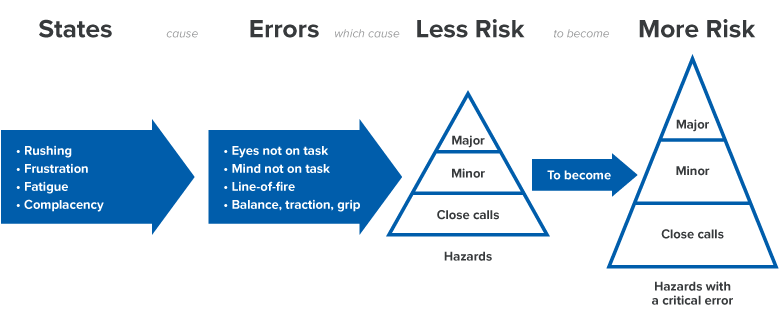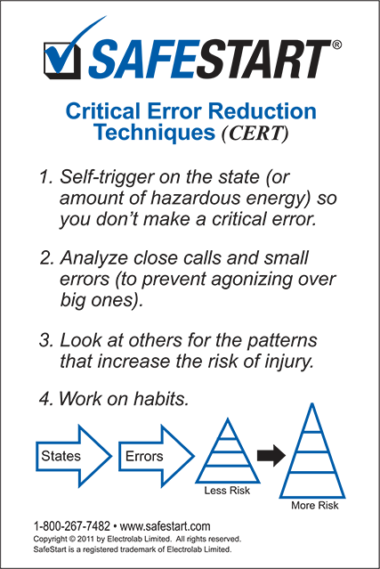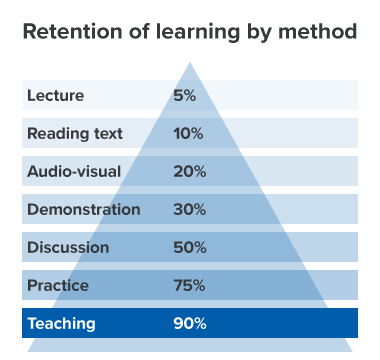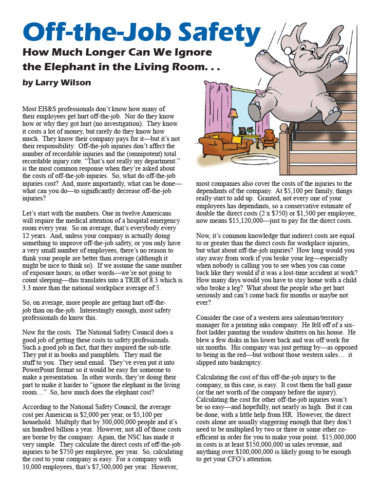This article by Larry Wilson appeared in the November 2007 Issue of the SafetyXChange Newsletter
How much longer can we ignore the elephant in the living room…
Most EH&S professionals don’t know how many of their employees get hurt off-the-job. Nor do they know how or why they got hurt (no investigation). They know it costs a lot of money, but rarely do they know how much. They know their company pays for it—but it’s not their responsibility. Off-the-job injuries don’t affect the number of recordable injuries and the (omnipotent) total recordable injury rate. “That’s not really my department.” is the most common response when they’re asked about the costs of off-the-job injuries. So, what do off-the-job injuries cost? And, more importantly, what can be done—what can you do—to significantly decrease off-the-job injuries?
Let’s start with the numbers. One in twelve Americans will require the medical attention of a hospital emergency room every year. So on average, that’s everybody every 12 years. And, unless your company is actually doing something to improve off-the-job safety, or you only have a very small number of employees, there’s no reason to think your people are better than average (although it might be nice to think so). If we assume the same number of exposure hours; in other words—we’re not going to count sleeping—this translates into a TRIR of 8.3 which is 3.3 more than the national workplace average of 5.
So, on average, more people are getting hurt off-the-job than on-the-job. Interestingly enough, most safety professionals do know this.
Now for the costs. The National Safety Council does a good job of getting these costs to safety professionals. Such a good job in fact, that they inspired the sub-title. They put it in books and pamphlets. They mail the stuff to you. They send email. They’ve even put it into PowerPoint format so it would be easy for someone to make a presentation. In other words, they’re doing their part to make it harder to “ignore the elephant in the living room…” So, how much does the elephant cost?
According to the National Safety Council, the average cost per American is $2,000 per year, or $5,100 per household. Multiply that by 300,000,000 people and it’s six hundred billion a year. However, not all of those costs are borne by the company. Again, the NSC has made it very simple. They calculate the direct costs of off-the-job injuries to be $750 per employee, per year. So, calculating the cost to your company is easy. For a company with 10,000 employees, that’s $7,500,000 per year. However, most companies also cover the costs of the injuries to the dependants of the company. At $5,100 per family, things really start to add up. Granted, not every one of your employees has dependants, so a conservative estimate of double the direct costs (2 x $750) or $1,500 per employee, now means $15,120,000—just to pay for the direct costs.
Now, it’s common knowledge that indirect costs are equal to or greater than the direct costs for workplace injuries, but what about off-the-job injuries? How long would you stay away from work if you broke your leg—especially when nobody is calling you to see when you can come back like they would if it was a lost-time accident at work? How many days would you have to stay home with a child who broke a leg? What about the people who get hurt seriously and can’t come back for months or maybe not ever?
Consider the case of a western area salesman/territory manager for a printing inks company. He fell off of a six-foot ladder painting the window shutters on his house. He blew a few disks in his lower back and was off work for six months. His company was just getting by—as opposed to being in the red—but without those western sales… it slipped into bankruptcy.
Calculating the cost of this off-the-job injury to the company, in this case, is easy. It cost them the ball game (or the net worth of the company before the injury). Calculating the cost for other off-the-job injuries won’t be so easy—and hopefully, not nearly as high. But it can be done, with a little help from HR. However, the direct costs alone are usually staggering enough that they don’t need to be multiplied by two or three or some other co-efficient in order for you to make your point. $15,000,000 in costs is at least $150,000,000 in sales revenue, and anything over $100,000,000 is likely going to be enough to get your CFO’s attention.
What Can Be Done About It?
Well, before getting into what can be done, that will be effective, that doesn’t require a lot of capital, etc., it might be worth addressing the “why me” question. Since, as mentioned earlier, rarely is it the safety professional’s department. The answer, quite simply, is that you’re the only one who can. Now this doesn’t mean you have do it all by yourself. You will probably need some support from your CFO. But think about it—nobody is likely going to be very interested in safety advice from an accountant or tax attorney, and while it’s likely that the people in the finance or disability management departments might be trying to negotiate a better deal with their HMO, insurance carriers, etc. because that’s part of their job—they’re not trying to decrease the number of injuries. They’re just trying to pay less for the injuries that do occur. And if the company is self-insured (as most big companies are), then they might not even be doing that.
So, even though it isn’t your job, and it’s not your responsibility, (like it or not) you’re really the only person who can make it happen, or at least start the process to make it happen.
Personally, I find that listening to hundreds and hundreds of stories a year about off-the-job injuries and fatalities is very motivating. I found that going to my secretary’s brother’s funeral over the Christmas holidays a few years ago supplied me with more motivation than I wanted. But hopefully, you’ll find yours in less extreme circumstances. In other words, there’s way more than just the money at stake here. Much more. The elephant kills 8,000 children in Canada and the U.S. every year. And that’s just the children…
Which brings us back to the question, “What can you really do to improve off-the-job safety?”. Let’s start with the easy stuff that some companies do, which doesn’t hurt but doesn’t make much of a difference either: sending first-aid kits home and offering safety glasses for the kids to wear when they’re mowing the lawn (not too expensive—but hardly free). Unfortunately, first-aid kits do not prevent injuries and not too many people lose their eyesight mowing the lawn. Nevertheless, nothing is “wrong” with either of these or similar things (flashlights, gloves, etc.).
What about taking traditional workplace safety methodology home? You know—job safety analyses, written procedures, pre-job inspection checklists, lockout/tagout, accident/incident investigations, etc. Well, first of all, not all of your employees know enough about these methodologies to teach them to their families… but you do. However, I’ve asked over 5,000 safety professionals if they have posted job safety analyses in their garages, or written procedures for refuelling or unclogging the lawnmower and all I got was a laugh. Maybe you do accident/incident investigations with your spouse or partner whenever he or she gets hurt, but nobody else I’ve talked to does. What about more modern approaches—like behavior based safety or observation and feedback processes? How many safety professionals trained in behavior based safety do you think go home and say, “Honey, let me give you some feedback on your at-risk behavior cooking dinner tonight.”? Answer: none—that are still married.
So what will work? What will make a real difference? Well, if you still subscribe to the “Hazards cause injuries” model of accident causation, you could try to provide training on the specific hazards in the house (fire, electricity, chemicals, etc.). However, this kind of training only helps if people don’t know about the hazards. If they already know about the stove being hot, the bathroom floor being slippery and the stairs/gravity thing, this kind of training won’t do very much good. Old information isn’t very motivating.
However, if you subscribe to the “Hazards are everywhere and coming into contact with them is what really causes injuries”, then you might be able to offer some real help—and do some real good.

If you stop and think about it for a second, most common hazards aren’t limited to the workplace. They’re everywhere, or almost everywhere. Gravity (at least) is everywhere. Slips and falls in the home account for about eight thousand accidental fatalities a year. So while it’s difficult to get hurt without a hazard or a source of hazardous energy, there are way more hazards than there are injuries. It’s only if that hazard contacts you or if you contact it, that there’s a problem. In other words, either the hazard or potentially hazardous energy hits you (you are in the path of the hazardous energy or in the line-of-fire), or you hit it. But you wouldn’t move into a hazard if you could see it or you were thinking about it, unless—you couldn’t stop yourself from moving into it (loss of balance, traction or grip). These four critical errors: eyes not on task, mind not on task, moving into (or being in) the line-of-fire or somehow losing your balance, traction or grip are involved in over 99% of all acute injuries (excluding contact sports).
But you can’t just leave it at that and say, “Try really hard not to make one of these four critical errors…”, because nobody is ever trying to make any mistakes or errors (big, small, injury causing, non-injury causing, etc.). So, we have to back up and look at what causes people to make mistakes: rushing, frustration, fatigue, complacency, extreme joy, extreme sorrow, panic, etc. However, from a practical point of view, or from a “which states are people in daily” point of view, we can narrow this list down to rushing, frustration, fatigue and complacency.
Coincidentally, over 99% of all acute accidental injuries have one of these four states (or a combination of them) as contributing factors. Four states lead to four critical errors, which will increase the risk of whatever task you’re doing—especially if you are moving. See Figure #1 (State to Error Risk Pattern).
Critical Error Reduction Techniques
Simply making people aware of this state to error risk pattern might be somewhat helpful, but if you want to really help them, you’ll need to do more than that. If you look at the pattern, you’ll see that the state comes before the error. This means we could use the state as a trigger to think about not making a critical error. However, this technique won’t work very well for complacency—as it’s much easier to tell that you’re in a rush, or you’re tired or frustrated. So, for complacency leading to mind not on task—and mind not on task leading to other critical errors—we’ll need to look at what people are doing automatically or habitually, since they aren’t thinking about what they’re doing. In other words, we’ll have to tell them what habits to improve (eg. move eyes before hands, feet, body or car), so that what they do automatically—or habitually—is safer.

Getting people to improve what they do automatically will definitely help to compensate for complacency leading to mind not on task. But it’s always better if you’re thinking about what you’re doing, because your habits and reflexes (alone) don’t give you the ability to anticipate a dangerous situation that’s about to occur so you can get yourself completely out of the line-of-fire. You need your mind for that. So we also need a way to help people get their mind back on task from wherever it may have drifted off to. However, if you start looking for these state to error patterns (once you start to see them, you’ll see them everywhere), then every time you do see one, it will almost automatically make you think about what you’re doing at the moment.

The last technique we need to teach people is to analyze their close calls and small errors to determine if it was a state like rushing, frustration or fatigue that they didn’t “self-trigger” on—or, if it was complacency leading to mind not on task, then it’s probably a habit that still needs more work. Now, teaching these techniques to people is one thing. (See Figure #2.) Getting them to put some effort into improving is another. In other words, they don’t just need information—they need training. But if you’re willing to invest the time, effort, etc. to train them well, the injury reductions—both on- and off-the-job will be more than worth it. Moreover, since these concepts are simple enough, with a few training aids, employees can also teach these concepts to their families, which helps the employee learn it even better. (See Figure #3.) If your company also pays for all of the employee’s dependants’ injuries, then the return on investment for this kind of training is huge. In some cases, it’s been over 500% in two years.
This type of training isn’t expensive (compared to traditional BBS), it works everywhere: at work, at home and on the highway—and, it’s been proven to work with over 1,000,000 employees.
In summary, you can do something about off-the-job safety—the elephant in the living room. Hopefully, you won’t have to go to a funeral first. Oh, and by the way, you’ll probably reduce your acute injuries at work by more than 50%.
Larry Wilson has been a behavior-based safety consultant for over 25 years. He has worked with over 2,500 companies in Canada, the United States, Mexico, South America, the Pacific Rim and Europe. He is also the author of SafeStart, an advanced safety awareness program currently being used by over 2,000,000 people in 50 countries worldwide.

Get the PDF version
You can download a printable PDF of the article using the button below.

